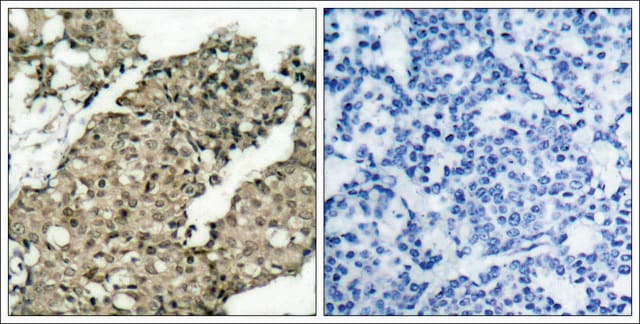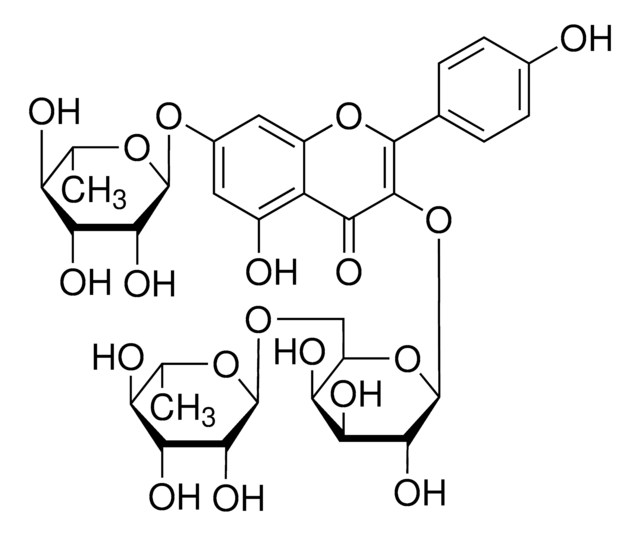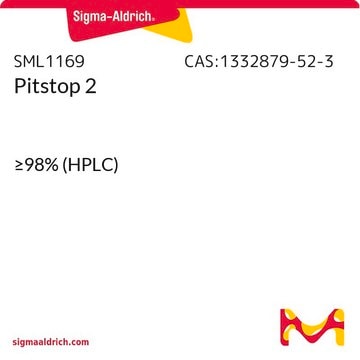345834
Genistein, Soybean
A cell-permeable, reversible, substrate competitive inhibitor of protein tyrosine kinases, including autophosphorylation of epidermal growth factor receptor kinase (IC₅₀ = 2.6 µM).
Synonim(y):
Genistein, Soybean, 4ʹ,5,7-Trihydroxyisoflavone
About This Item
Polecane produkty
Poziom jakości
Próba
≥95% (HPLC)
Postać
solid
producent / nazwa handlowa
Calbiochem®
warunki przechowywania
OK to freeze
protect from light
kolor
white
rozpuszczalność
DMSO: 200 mg/mL
Warunki transportu
ambient
temp. przechowywania
−20°C
InChI
1S/C15H10O5/c16-9-3-1-8(2-4-9)11-7-20-13-6-10(17)5-12(18)14(13)15(11)19/h1-7,16-18H
Klucz InChI
TZBJGXHYKVUXJN-UHFFFAOYSA-N
Opis ogólny
Działania biochem./fizjol.
EGFR kinase
Ostrzeżenie
Inne uwagi
Wei, H., et al. 1995. Proc. Soc. Exp. Biol. Med. 208, 124.
Wei, H., et al. 1995. Carcinogenesis17, 73.
Kobayashi, S., et al. 1994. J. Biol. Chem.269, 9011.
Migita, K., et al. 1994. J. Immunol.153, 3457.
Spinozzi, F., et al. 1994. Leuk. Res.18, 431.
Dhar, A., et al. 1990. Mol. Pharmacol.37, 519.
Hill, T.D., et al. 1990. Science248, 1660.
Dean, N.M., et al. 1989. Biochem. Biophys. Res. Commun.165, 795.
Akiyama, T., et al. 1987. J. Biol. Chem.262, 5592.
Informacje prawne
Hasło ostrzegawcze
Warning
Zwroty wskazujące rodzaj zagrożenia
Zwroty wskazujące środki ostrożności
Klasyfikacja zagrożeń
Acute Tox. 4 Oral
Kod klasy składowania
11 - Combustible Solids
Klasa zagrożenia wodnego (WGK)
WGK 3
Temperatura zapłonu (°F)
Not applicable
Temperatura zapłonu (°C)
Not applicable
Certyfikaty analizy (CoA)
Poszukaj Certyfikaty analizy (CoA), wpisując numer partii/serii produktów. Numery serii i partii można znaleźć na etykiecie produktu po słowach „seria” lub „partia”.
Masz już ten produkt?
Dokumenty związane z niedawno zakupionymi produktami zostały zamieszczone w Bibliotece dokumentów.
Klienci oglądali również te produkty
Nasz zespół naukowców ma doświadczenie we wszystkich obszarach badań, w tym w naukach przyrodniczych, materiałoznawstwie, syntezie chemicznej, chromatografii, analityce i wielu innych dziedzinach.
Skontaktuj się z zespołem ds. pomocy technicznej












